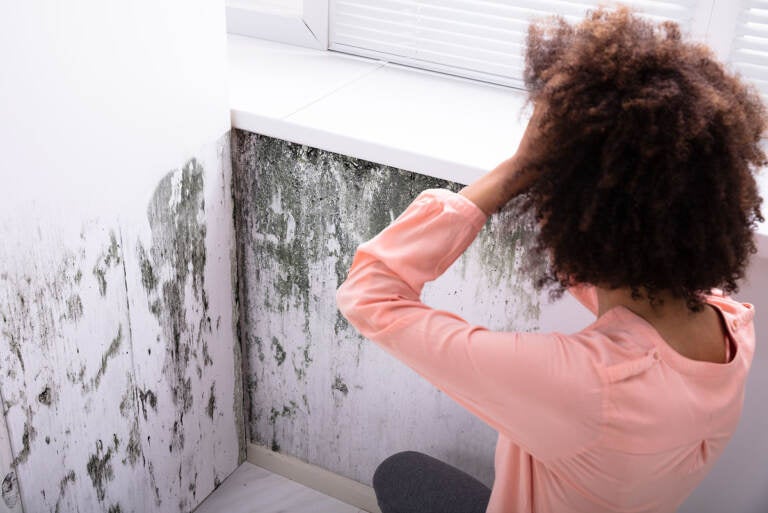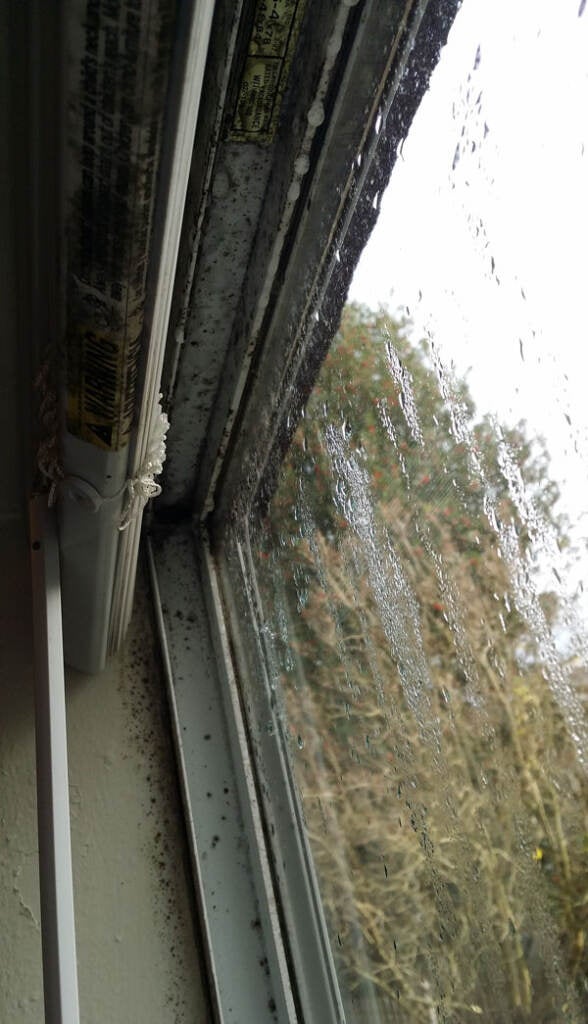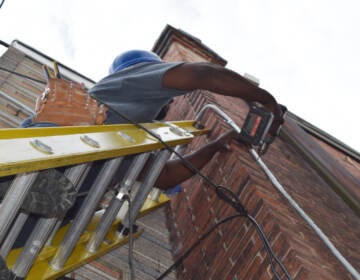In rainy Washington state, weak laws squash tenants’ rights to mold remediation
Washington’s landlord-tenant law shrugs at tenants and winks at landlords, especially when it comes to mold. Not so in New York and California.
Listen 07:08
Washington’s landlord-tenant law shrugs at tenants and winks at landlords, especially when it comes to mold. Not so in New York and California. (AndreyPopov)
This story is from The Pulse, a weekly health and science podcast.
Find it on Apple Podcasts, Spotify, or wherever you get your podcasts.
The odd-sized rear door in my bedroom and the window next to it hung within a cracked concrete exterior wall that trapped every bit of precipitation nature offered.
The West Seattle apartment was in a midcentury brick structure that had once been a hardware store. Its conversion accommodated several small units, roughly renovated. And the old place was riddled with mold.
When the owner showed the two-bedroom apartment in early June 2013, it was still occupied, and the departing tenant’s belongings were stacked in ways that hid problem areas from view. Throughout the summer months, my son and I would have no idea of the mold and moisture painstakingly hidden beneath new coats of paint.
But in September, the rains came, the cold set in, and our true suffering began.

My initial written report of mold, submitted by email to the landlord-property owners, Lance and Galina Betz of G & L Holdings LLC, on Oct. 11, 2013, was followed by six months of the same complaint relayed in person and by email, remitting timely rent throughout this period.
By December, Seattle’s average low temperature was 18 degrees. A broken heating system, a violation of the Seattle Municipal Code, exacerbated the problem within the walls. In my bedroom, icicles melted into pools of water beneath space heaters and extension cords.
In spring the following year, the city’s Department of Construction and Inspection, the entity responsible for most code enforcement in the greater Seattle area, visited the apartment at my request. DCI informed the landlords of several structural violations and ordered superficial repairs that did not remediate the underlying causes of condensation and mold in the unit. With regard to the unsealed exterior wall “bleeding” through to the interior walls, and the resulting failure to achieve weathertightness in the apartment as required by law, the landlords told DCI they would replace the wall after the expiration of my lease.
In New York and California, that response from a landlord would not stand. Under New York City law, homeowners must carry out annual inspections for mold and other indoor allergen hazards, and remediate underlying causes. Under California’s Senate Bill 655, “visible mold growth” has been classified as a type of inadequate sanitation that must be abated by landlords and property owners.
No tenants’ rights or remedies
Washington’s landlord-tenant law, however, shrugs at tenants and winks at landlords when it comes to mold.
Washington state law requires landlords to keep the premises fit for human habitation during tenancy, to maintain the dwelling unit in reasonably weathertight condition, and maintain structural elements in “reasonably good repair.”
Yet shortly after the visit from DCI, when Krysta Thornton, a master home environmentalist with the American Lung Association, came to the apartment to conduct a healthy home checkup — an assessment meant to identify health hazards such as mold and mildew, dust mites, and ventilation issues — she immediately noted the “actively wet” interior and exterior bedroom walls, signs of water damage and mold, and the absence of heating sources in the apartment as required by the Seattle Municipal Code.
“A fully functional heating source is essential in mold prevention,” wrote Thornton. “[And] any materials where mold cannot be removed from surfaces … should be discarded.”

In April 2014, after transmitting the Lung Association’s assessment to the landlords and again asking them to remediate the mold, they refused. They offered to terminate the lease, and directed me to the mold addendum — a mandatory disclosure under Senate Bill 5049 that requires that landlords notify tenants about mold.
The mold addendum doesn’t compel landlords to show and tell where mold exists in a rental property. Far from it. Instead, what it requires is landlord-to-tenant dissemination of information about the health hazards associated with exposure to indoor mold.
A tenant’s written acknowledgment of receipt of the mold addendum proves a landlord’s compliance, but the addendum doesn’t grant tenants specific rights or remedies in the event of mold. The addendum simply advises tenants to use bleach and water if mold develops — which, according to the Environmental Protection Agency, is not recommended as a routine practice during mold cleanup.
That’s it. That’s the mandatory disclosure on mold in Washington state.
Health implications of living with indoor mold
Penicillium and Aspergillus spores, commonly known as mold, are naturally occurring in soil. Because they’re very small and lightweight, they’re often airborne and easily distributed, so whenever we open windows and doors, whenever we enter from the outside, we’re introducing fungal spores to indoor environments.
Estelle Levetin, a professor emeritus of biological science at the University of Tulsa, said this kind of spore migration isn’t a problem.
“The problem occurs when the presence of moisture indoors triggers spore germination and growth. That’s when the indoors can [become] contaminated,” Levetin said.
And dampness can cause problems beyond mold. According to Levetin, studies have shown that indoor dampness can lead to mold growth, which can be associated with asthma development.
In his paper “Adverse Health Effects of Indoor Molds,” industrial hygienist Luke Curtis concluded that “exposure to high levels of indoor mold can cause injury to and dysfunction of multiple organs and systems, including respiratory, hematological, immunological, and neurological systems, in immunocompetent humans.”
Mold spores can cause pneumonia, nerve damage, and death, especially for asthmatics and immuno-altered and immunocompromised people. And Levetin said there is an association between dampness, fungal growth, and respiratory tract symptoms. When inhaled, mold spores land on our nasal passages, or they may travel deep into our respiratory system to our lungs.
How to identify mold in your home and take action
The first step in protecting against the effects of mold is knowing how to identify it.
When there’s a moldy odor, start investigating with your eyes, said Levetin, the biological sciences professor at the University of Tulsa. Open cabinets, look beneath sinks, check the bathrooms, she advised. Is there evidence of moisture? Are there rings on the ceiling or walls? Ask about recent structural events and plumbing problems, like a leaky attic or a flooding basement.
Also important to note, she said, is that when a space is too tightly sealed, accumulated moisture from regular indoor activities such as washing clothes and dishes, taking baths and showers, and even cooking can be cause for concern.
“There’s no perfectly sealed structure, there’s always some way that moisture can get in, and not all fungal spores are going to cause problems,” said Levetin. “Freestanding air cleaners are effective, especially the ones with HEPA filters.”
The goal is a healthy balance between weathertightness and steady airflow.
Subscribe to The Pulse
Favoring landlords over tenants
Across the nation, where mold laws are weak or nonexistent, renters may feel helpless in their pursuit of safe and affordable space.
Tram Tran-Larson is a community engagement manager at the Housing Justice Project in King County, Washington, which provides free legal assistance to renters facing eviction. According to Tran-Larson, there are no explicit protections from mold for tenants in Washington state, and the law doesn’t hold landlords liable when they don’t provide the mold addendum. Even though the law is weak and offers few explicit rights and remedies on the tenant side, she said landlords still fight it pretty hard.
“Structural damage means thousands of dollars in repairs, or potentially a demo, and it’s hard to prove who caused [the mold] just because who knows how long it’s been there,” Tran-Larson said.
Together, when it comes to mold, Washington’s landlord-tenant law and the mold addendum increase renters’ vulnerability to owners’ claims of property damage, and even renters’ risk of homelessness.
Withholding rent isn’t a route to mold remediation, either. According to the Tenants Union of Washington, even when units are in desperate need of repair, withholding rent makes tenants vulnerable to eviction.
Tran-Larson said Washington law provides remedies for landlords’ quick removal of tenants, but it does not give equal power to tenants who need quick repairs when landlords refuse. When renters are behind in payment, it’s harder for them to get repair requests granted. Under Washington’s landlord-tenant law, a tenant’s duty to maintain timely rental payments is prioritized above the landlord’s duty to provide a safe living space.
Pandemic-related eviction moratoriums established and extended since spring 2020 postponed a flood of evictions. Still, moratorium policy, like the state’s landlord-tenant law, continues to favor and protect property owners. The moratorium provides a loophole by which property owners can legally initiate an eviction, including when indoor mold is at issue. By claiming a need to evict a tenant in order to address “a significant and immediate risk to the health, safety, or property of others created by the resident,” property owners are likely to overcome the eviction moratorium.
Importantly, in the phrase “created by the resident,” the moratorium suggests it is possible to know the origin of the risk, in this case, mold, and to make the originator accountable for its effects.
That starkly contrasts with Washington’s mold addendum, which is silent on determination of responsibility and accountability when tenants live with indoor mold at significant risk to their own health, safety, and property.
Indoor mold is pervasive across the nation
After many months of relaying to the landlords the need for mold remediation, I gave notice to vacate the apartment, and we left in May 2014, taking the related health effects with us.
Unfortunately, experiences like ours aren’t rare. Indoor mold is an issue countrywide. An estimated 70% of homes have mold behind the walls.
According to Tran-Larson, in the Pacific Northwest, there’s an assumption and expectation that mold is everywhere, and is going to be everywhere. That strengthens logical fallacies that even prevalent indoor mold in Washington state is benign because the Washington law takes no strong position against it.
The Housing Justice Project is frequently contacted by renters distressed about their moldy living situations. The organization has worked with families forced out of their homes by life-threatening levels of indoor mold. Tran-Larson recalled one case in which “the mold was so bad and so toxic that when [our attorney] went to visit the house, he couldn’t breathe.” Ultimately, after covering the cost of mold inspection in the rental property, the tenant family moved. They had no other option, and Tran-Larson said Seattle’s Department of Construction and Inspection did nothing to address the issue.
Once renters have signed leases and families have moved in, only to discover recurring mold problems, the Housing Justice Project advises them to file complaints with the Construction and Inspection Department. Tran-Larson said the department may not investigate the situation, so there’s a chance nothing will come of it. She said a tenant’s civil claim against a property owner is the only possible relief in these situations, but it’s unlikely because it assumes tenants have the knowledge, time, and money to navigate the legal system.
A wider lens reveals environmental racism operating in communities where renters are mostly Black and brown low-wage earners. According to studies by the Centers for Disease Control and Prevention, because poverty and sustained exposure to pollution occurs in neighborhoods where the majority of residents are people of color, the rate of asthma is unequally distributed across racial groups. And asthma rates decrease as family income increases. Black Americans and American Indians/Alaska Natives have the highest current asthma rates compared to other races and ethnicities. Specifically, Black Americans are 42% more likely than white Americans to have asthma.
I’m a Black woman, and my son is now a Black man. Subjected to long-term exposure to mold in that West Seattle apartment, our health risks were multiplied.
New York and California may provide legislative blueprints
Mold law in Washington state is featherweight compared to the mold laws of California and New York.
When I called the office of Washington Gov. Jay Inslee and asked a housing policy adviser what the governor was doing to protect people from mold in rental property, he struggled to respond and said he’d get back to me, but never did. My calls to the offices of U.S. Sens. Patty Murray and Maria Cantwell and to Seattle’s former mayor Jenny Durkan, where I presented the same question, were not returned.
That’s no surprise to Tran-Larson, the tenants rights advocate.
In fall 2019, Washington’s Housing Justice Project pushed for a summary proceeding bill that would have given tenants a quick way to deal with housing violations and housing codes, but it failed, and as far as the organization is aware, nothing similar is going to be introduced.
Tran-Larson said it seems as if elected officials don’t want to touch the issue.
California and New York have acknowledged the dangers of toxic housing, and have passed laws that carry consequences for landlords who endanger the public, who strategize to shirk responsibility for substandard housing. In moisture-rich Washington, we need lawmakers to do the same.
For every state with toothless mold laws, California and New York have provided blueprints to pattern after now — before the next rain comes.
“Public pressure is what’s needed,” said Tran-Larson. “That’s how we get anything done. They need to hear from [those] being affected [that] this is something they should care about.”
Support for WHYY’s coverage on health equity issues comes from the Commonwealth Fund.
WHYY is your source for fact-based, in-depth journalism and information. As a nonprofit organization, we rely on financial support from readers like you. Please give today.






